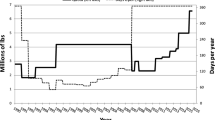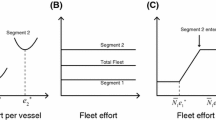Abstract
An alternative to traditional regulations of fisheries to avoid rent dissipation is the use of individual transferable quotas (ITQ s ) where prices in the quota market provide the necessary information to owners of harvest rights to contract with each other. However, even under such a decentralized regime, information on the underlying technology of the fishing vessels is also necessary. First, since most fisheries consist of many interrelated production processes, in order to avoid rent dissipation by discarding wrong output mix etc., the structure of production in the multispecies fishery must be known to design a proper quota system. Second, an ITQ system may create incentives for misreporting by understating the actual catch. This may especially be the case where the expected degree of self-enforcement is low. The paper proposes a way to reduce the information requirements under regulation with asymmetric information by constructing a typical firm and comparing performance for the other vessels to this firm. Based on the typical firm, and if the industry is relatively homogenous, the performance and hence catch of any other firm in the industry can be predicted within a certain range. Further, the paper applies this idea to the Norwegian trawler fleet to assess the production structure in terms of jointness, input-output separability, and the supply and demand elasticities for the fishing firms. This information characterizes the fishery and thus how the quota system may be designed and how to construct a yardstick in order to reduce the enforcement cost under a decentralized regulation of ITQs.
Similar content being viewed by others
References
Anderson, L. G. (1989), ‘Conceptual Constructs for Practical ITQ Management Policies’, in Neher, Arnason and Mollett, eds.,Rights Based Fishing, Dordrecht, The Netherlands: Kluwer Academic Publishers.
Anderson, L. G. (1991), ‘Total Allowable Catch in Regulated Fisheries’,Land Economics 67(2), 141–157.
Arnason, R. (1989), ‘Minimum Information Management with the Help of Catch Quotas’, in Neher, Arnason and Mollett, eds.,Right Based Fishing, Dordrecht, The Netherlands: Kluwer Academic Publishers.
Arnason, R. (1990), ‘Minimum Information Management in Fisheries’,Canadian Journal of Economics 23, 101–124.
Barten, E. R. (1969), ‘Maximum Likelihood Estimation of Complete System of Demand Equations’,European Economic Review 1, 7–73.
Bjørndal, T. (1988), ‘Production in a Schooling Fishery: The Case of the North Sea Herring Fishery’,Land Economics 65, 49–56.
Campbell, H. F. (1991), ‘Estimating the Elasticity of Substitution between Restricted and Unrestricted Inputs in a Regulated Fishery: A Probit Approach’,Journal of Environmental Economics and Management 20(3), 262–274.
Copes, P. (1986), ‘A Critical Review of the Individual Quota as a Device in Fisheries Management’,Land Economics 62(3), 278–291.
Denny, M. and M. Fuss (1977), ‘The Use of Approximation analysis to Test for Separability and the Existence of Consistant Aggregates’,American Economic Review 67, 404–418.
Denny, M. and C. Pinto (1978), ‘An Aggregate Model with Multiproduct Technologies’, in M. Fuss and D. McFadden, eds.,Production Economics: A Dual Approach to Theory and Applications 2, Amsterdam: North-Holland.
Dupont, D. P. (1991a), ‘Testing for Input Substitution in a Reglated Fishery’,American Journal of Agricultural Economics 72(1), 155–164.
Dupont, D. P. (1991b), ‘Rent Dissipation in Restricted Access Fisheries’,Journal of Environmental Economics and Management 19(1), 26–44.
Dupont, D. P. and S. A. Phipps (1991), ‘Distributional Consequences of Fisheries Regulations’,Canadian Journal of Economics 24(1), 206–220.
Fudenberg, D. and E. Maskin (1986), ‘The Folk Theorem of Repeated Games with Discounting and Incomplete Information’,Economitrica 50, 533–554.
Grafton, Q. (In press), ‘Rent-Capture in a Rights Based Fishery’,Journal of Environmental Economics and Management.
Hannesson, R. (1983), ‘Bioeconomic Production Function in Fisheries: Theoretical and Empirical Analysis’,The Canadian Journal of Fisheries and Aquatic Science 40, 968–982.
Hannesson, R. (1991),Bioeconomic Analysis of Fisheries, Institute of Fisheries Economics, Norwegian School of Economics and Business Administration, Bergen, Norway.
Kandori, M. (1992), ‘Social Norms and Community Enforcement’,The Review of Economic Studies 59, 63–80.
Kirkley, J. and I. Strand (1988), ‘The Technology and Management of Multispecies Fisheries’,Applied Economics 20, 1279–1302.
Laitinen, K. (1980),A Theory of the Multiproduct Firm, Amsterdam: North-Holland.
Laffont, J. J. and J. Tirole (1983),A Theory of Incentives in Procurement and Regulation, MIT Press, Cambridge, MA.
Libecap, G. B. (1989a), ‘Comments to Scott (1989)’, in Neher, Arnason and Mollett, eds.,Rights Based Fishing, Dordrecht, The Netherlands: Kluwer Academic Publishers.
Libecap, G. B. (1989b), ‘Comments to Anderson (1989)’, in Neher, Arnason and Mollett, eds.,Rights Based Fishing, Dordrecht, The Netherlands: Kluwer Academic Publishers.
McFadden, D. L. (1978), ‘Cost, Revenue, and Profit Functions’, in M. A. Fuss and D. L. McFadden, eds.,Production Economics, Amsterdam: North-Holland.
Moloney, D.G. and P.H. Pearse (1979), ‘Quantitative Rights as an Instrument for Regulating Commercial Fisheries’,Journal of Fisheries Research Board of Canada 36, 859–866.
Sakai, Y. (1974), ‘Substitution and Expansion Effects in Production Theory: The Case of Joint Production’,Journal of Economic Theory 9, 255–274.
Schleifer, A. (1985), ‘A Theory of Yardstick Competition’,Rand Journal of Economics 16, 319–327.
Scott, A.D. (1989), ‘Conceptual Origions of Rights Based Fishing’, in Neher, Arnason and Mollett, eds.,Rights Based Fishing, Dordrecht, The Netherlands: Kluwer Academic Publishers.
Squires, D. (1987a), ‘Public Regulation and the Structure of Production in Multiproduct Industries: An Application to the New England Otter Trawl Industry’,Rand Journal of Economics 18, 232–248.
Squires, D. (1987b), ‘Fishing Effort: Its Testing, Specification and Internal Structure in Fisheries Economics and Management’,Journal of Environmental Economics and Management 14, 268–282.
Squires, D. (1988), ‘Production Technology, Costs, and Multioutput Industry Structure: An Application of the Long-Run Profit Function to the New England Fishing Industry’,Canadian Journal of Economics 21(2), 359–378.
Squires, D. (1992), ‘Productivity Measurement in Common Property Resource Industries: An Application to the Pacific Coast Trawl Fishery’,Rand Journal of Economics 23, 221–236.
Squires, D. and J. Kirkley (1991), ‘Production Quota in Multi-product Pacific Fisheries’,Journal of Environmental Economics and Management 21, 109–126.
Wales, T. (1977), ‘On the Flexibility of Flexible Functional Forms: An Empirical Approach’,Journal of Econometrics 5, 183–193.
Weaver, R. E. (1983), ‘Multiple Input, Multiple Output Production Choices, and Technology in the U.S. Wheat Region’,American Journal of Agricultural Economics 65, 45–56.
Weitzman, M. (1974), ‘Prices vs. Quantities’,Review of Economic Studies 41, 50–65.
Zellner, A. (1962), ‘An Efficient Method of Estimating Summingly Unrelated Regressions and Tests for Aggregation Bias’,Journal of american Statistical Association 57, 348–368.
Author information
Authors and Affiliations
Additional information
The authors would like to thank Trond Bjørndal, Røgnvaldur Hannesson, Ola Flaaten and two referees for useful comments and suggestions.
Rights and permissions
About this article
Cite this article
Salvanes, K.G., Squires, D. Transferable quotas, enforcement costs and typical firms: An empirical application to the Norwegian trawler fleet. Environ Resource Econ 6, 1–21 (1995). https://doi.org/10.1007/BF00691408
Issue Date:
DOI: https://doi.org/10.1007/BF00691408




